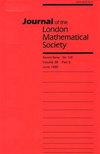通过随机量化的简单构造正弦戈登模型
IF 1.2
2区 数学
Q1 MATHEMATICS
Journal of the London Mathematical Society-Second Series
Pub Date : 2025-06-25
DOI:10.1112/jlms.70214
引用次数: 0
摘要
我们给出了低于第一阈值(β 2 &lt;4 π $\beta ^2 < 4\pi$),在有限和无限体积设置下,通过研究相应的抛物线正弦-戈登模型。我们还建立了有限体积下β 2 &lt的双曲正弦-戈登模型的路径全局适定性;2 π $\beta ^2 < 2\pi$。本文章由计算机程序翻译,如有差异,请以英文原文为准。



A simple construction of the sine-Gordon model via stochastic quantization
We present a simple PDE construction of the sine-Gordon measure below the first threshold (), in both the finite and infinite volume settings, by studying the corresponding parabolic sine-Gordon model. We also establish pathwise global well-posedness of the hyperbolic sine-Gordon model in finite volume for .
求助全文
通过发布文献求助,成功后即可免费获取论文全文。
去求助
来源期刊
CiteScore
1.90
自引率
0.00%
发文量
186
审稿时长
6-12 weeks
期刊介绍:
The Journal of the London Mathematical Society has been publishing leading research in a broad range of mathematical subject areas since 1926. The Journal welcomes papers on subjects of general interest that represent a significant advance in mathematical knowledge, as well as submissions that are deemed to stimulate new interest and research activity.

 求助内容:
求助内容: 应助结果提醒方式:
应助结果提醒方式:


